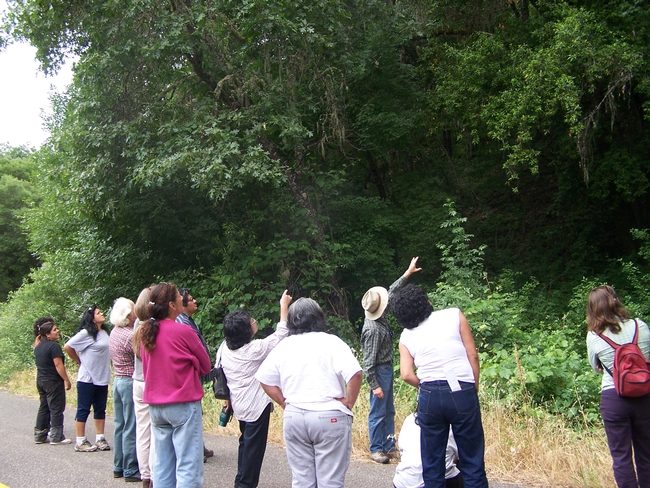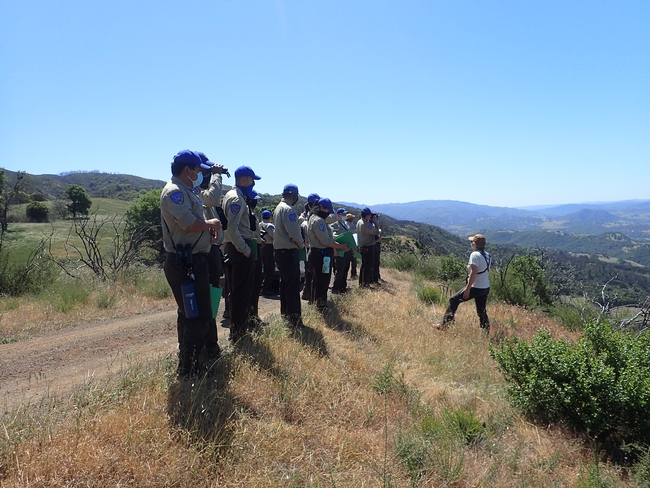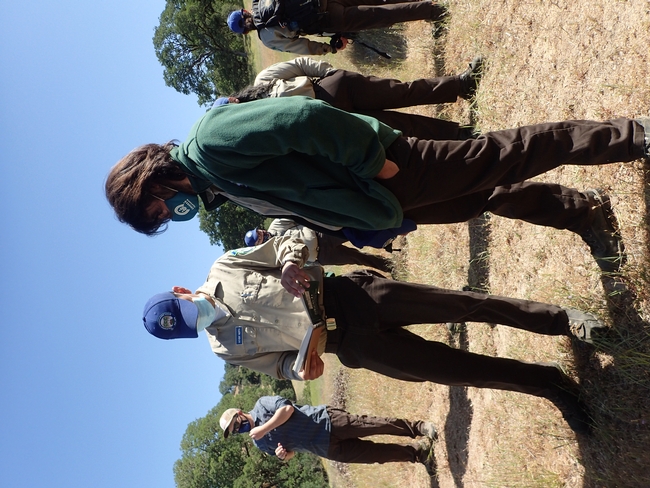Posts Tagged: Hopland Research and Extension Center
Tribal Engagement at the Hopland Research and Extension Center
The Hopland Research and Extension Center is situated on the traditional, ancestral and unceded lands of the Shóqowa and Hopland People, whose historical and spiritual relationship with these lands continues to this day and beyond (for more on the Land and people history of the site, see this story map). It was, and continues to be, difficult for Indigenous people to thrive in the Shanél Valley after they were forced off the fertile land and had to resettle on relatively small upland parcels and away from freshwater sources. UC ANR staff and academics at the Hopland Research and Extension Center are working to build relationships with the Hopland Band of Pomo Indians who live and work next door at the Hopland and Nacomis Rancherias.
Hopland REC Director John Bailey is committed to building relationships with the intention of enabling maximum benefits for local tribal communities. Tribal Chairperson Sonny Elliot and the Council have been helping us find ways to collaborate after a long history of distrust and despite the University's founding using the sales of expropriated lands (Land-Grant College Act, 1862) and our continued occupation of California Indian territories. Bailey is working with local tribes to define a newly funded Academic Advisor position to build relationships, advance UC policy around working with Tribes, and restore good fire to the landscape with the help of cultural practitioners.
We have secured funding to hire a Native college student to help revitalize ecocultural wetlands in Hopland this summer. The intern will spend time talking with Indigenous people living within the oak woodland landscape or North Coast California and develop a plan for stewarding ecoculturally important sites at the Hopland Research and Extension Center with the Hopland Band of Pomo Indians and local experts in traditional ecological knowledge. This internship offers an opportunity for a Native American college student or two to learn about wetland systems and traditional ecological knowledge; and share their experience with other tribal community members.
Hunting opportunities for Tribal youth and their families and plant collection sites for basket materials are available. The hope is that more cultural ceremonies can take place where generations of Pomo people spent time near the waterways that span Hopland REC. Finally, together we are exploring ways to modify access of existing roads at Hopland REC to allow for potential emergency evacuation for Rancheria residents.
More to come, we hope.
New wave of California Naturalists emerge from course at Hopland REC
Thirty-eight young, budding naturalists sit in a meadow while journaling and sketching their observations of the wildflowers and birds around them. They have come from various educational backgrounds to gather at the University of California Agriculture and Natural Resources' Hopland Research and Extension Center (REC) to learn about local natural ecosystems through a California Naturalist course.
Although they vary in expertise, these students share a common motivation: immerse themselves in the natural world and eventually teach others about its importance.
“The class really changed the way I view the world around me,” said Will Zuniga, a recent class participant at Hopland REC. “Now that I've taken it, I don't just see plants around me – I see stories. I understand more about the relationship that all of nature's moving parts have with each other. The class has given me more drive to learn about the world around me and to teach others as well.”
Under the UC ANR umbrella, the California Naturalist Program certifies participants through an immersive 40+ hour class delivered by one of its partner organizations, in this case, the California Conservation Corps (CCC). Aged 18 to 25 (and U.S. military veterans up to age 29) and from diverse educational backgrounds across the state, these California Naturalist students worked hard to fulfill the mission of the CCC – to protect and enhance California's natural resources and communities through education and service.
The California Naturalist Program promotes environmental literacy and stewardship through discovery and action. The program is designed to introduce Californians to the wonders of our unique ecology, engage the public in the study and stewardship of California's natural communities, and increase community and ecosystem resilience. Many other states have similar naturalist programs, but this is the first statewide program in California.
“California Naturalist training allows people of different backgrounds to come together to set what is the standard for how we talk about the sky, the ground below us, and the water that's flowing around us,” reflected Jacob Croasdale, a former class participant. “[They teach us] how to engage respectfully in a way that allows us to both receive and give back to nature.”
Although students graduate with broad knowledge of California's natural wonders, prior knowledge of the course's subject matter is unnecessary. “At first, I thought…I don't belong here. I'm just this artist - what do I have to offer?” shared Monique Wales, another former class participant. “There were Master Gardeners, geologists, biologists and people with crazy amounts of knowledge. But we all came together with such enthusiasm, and we wanted to learn from each other. It was such a fun group.”
“People who are thinking about the California Naturalist program but aren't sure that they know enough to step into something where the language is maybe more technical than they're familiar with should not be intimidated,” added Pete Devine, resident naturalist at Yosemite Conservancy. “A lot of participants are beginners and just generally interested folks. These people belong in the California Naturalist Program.”
A quick peek at the syllabus reveals many themes, field trips and interactions with local experts that culminate in the well-rounded knowledge necessary to help preserve our unique ecosystems. California has an incredibly diverse range of wildlife, habitats, rivers, lakes and coastal resources – wild and urban alike – and ecosystem and community resilience are essential.
After the course is completed, California Naturalists perform service through education and interpretation, stewardship, participatory science, environmental program support, community resilience and environmental justice. To date, certified California Naturalists, together with Climate Stewards (another component of the program), have volunteered more than 250,000 hours, worth over $7 million, in 52 of 58 counties in California.
The relationship between CCC and California Naturalist was piloted at the Hopland REC over the last two years and is now being rolled out across the state with support from the Prop 64 Youth Community Access fund. Overall, the project aims to offer three California Naturalist instructor trainings for 48 youth leaders, 24 California Naturalist certification courses for 480 Corps members, visits to or engagement with over 40 unique cultural and natural resources around the state each year, and 3,840 hours of service-learning outreach through youth-led video capstone projects promoting natural and cultural resources.
Overall (and most importantly), the California Naturalist Program allows corps members to have a solid connection to the “why” of their hard work.
Perhaps if we can all connect a bit more with nature in our backyard, we too will see the stories hidden in the plants, water, animals and land.
Bee-ing All You Can Be and See and Do
What a weekend for bee and gardening enthusiasts! It's a shame we all can't clone ourselves and be in two places at the same time! The 40th annual...
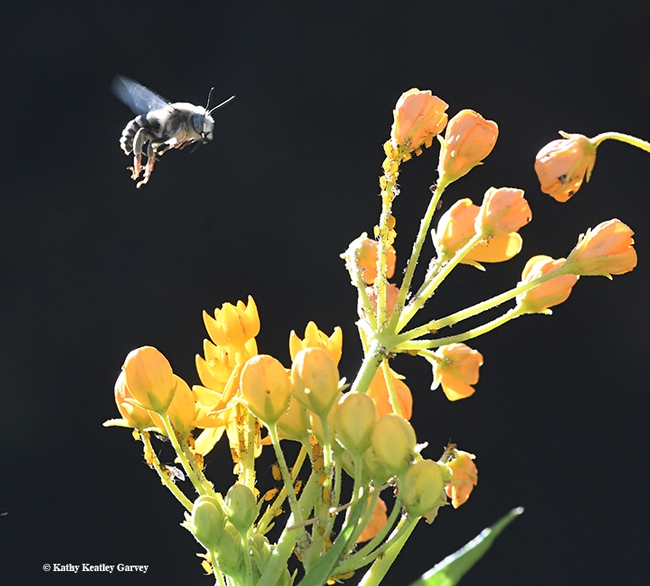
A native bee, Anthophora urbana, buzzes over a tropical milkweed. (Photo by Kathy Keatley Garvey)
What's That Bee? How to Identify and Attract Native Bees to Your Garden
Have you ever seen a bee buzzing around your garden and wondered: "What's that bee?" Or have you ever seen a bee nectaring in a community garden and...
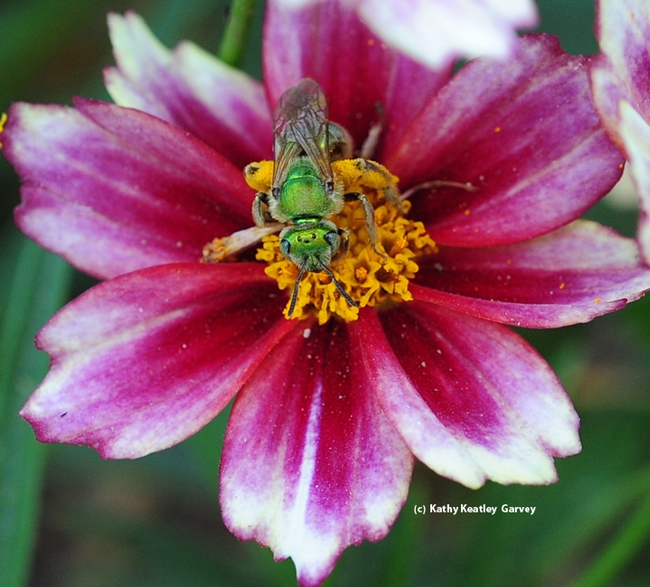
A female ultra green sweat bee, Agapostemon texanus, on Coreopsis tinctora 'Mahogany.' (Photo by Kathy Keatley Garvey)
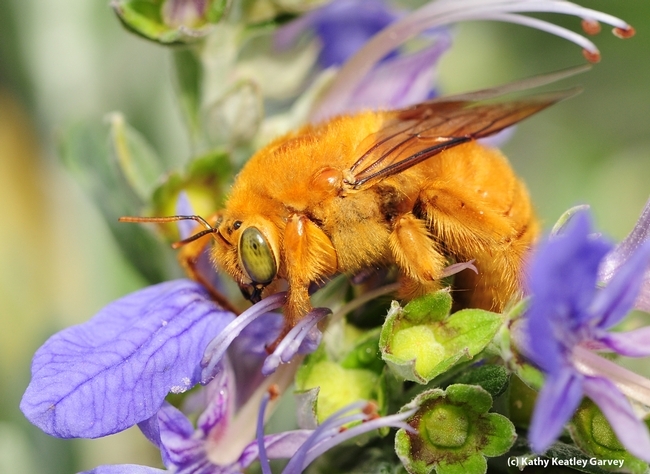
A male Valley carpenter bee (Xylocopa varipuncta) "the teddy bear bee" on germander. (Photo by Kathy Keatley Garvey)

A digger bee, a male Anthophora urbana, on lavender. (Photo by Kathy Keatley Garvey)
'Wild and wooly' sheep shearing class held at Hopland
Many sheep shearing students said the process was "the hardest thing they have ever done," reported Glenda Anderson in the Santa Rosa Press Democrat. The newspaper ran a lengthy feature and a photo gallery of the annual sheep shearing school held at the UC Hopland Research and Extension Center this week.
Reporter Justine Frederiksen of the Ukiah Daily Journal also reported on the sold-out sheep shearing and wool classing training at the 5,300-acre Mendocino County research center.
“And 60 percent of these people had never even touched a sheep before,” said John Harper, UCCE advisor and shearing school leader. Nearly all the students were women and included an artist from San Francisco, a retired fire chief, a UC Davis graduate student, and a woman who was learning to shear ahead of travels to New Zealand “because I think it will be a good skill to have for work, in case I want to stay for a couple of months.”
“One of the things new students have the most trouble with is what we call ‘tipping' the sheep, or flipping them over,” Harper said. He explained that, to get the sheep into the ideal starting position, you need to push its back legs down with one hand and tuck its head in with the other, twisting the animal into a sitting position with all four legs dangling.
UC Hopland REC sheep shearing students are part of a new wave of sheep shearers and wool enthusiasts industry officials hope will reverse decades of disinterest and decline. The shearing classes were booked well ahead of time, said Hannah Bird, a community educator at the research station. Many students are seeking a break from city life or jobs tying them to a desk.
Wrote reporter Glenda Anderson, shearing sheep is sweaty, back-straining work that earns just $2 to $5 per sheep. But an expert sheep shearer taking part in the program said sheep shearing for a living has its benefits.
“It's a lifestyle thing. I could work six months a year and travel around the world,” paying for the travel by working here and there, he said.


